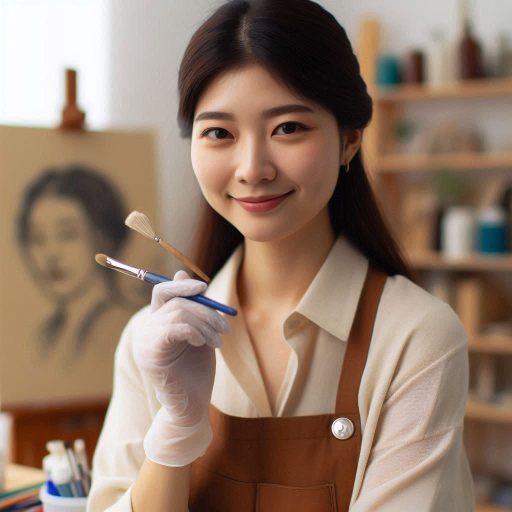Introduction
Choosing the right art conservation specialty is crucial for preserving and restoring artwork effectively.
In the field of art conservation, some options include paintings, sculptures, textiles, paper, and photographs.
Selecting the appropriate specialty ensures that conservators have the necessary skills and expertise to properly care for specific types of art.
By understanding the importance of choosing the right art conservation specialty, conservators can better serve the art community and protect cultural heritage.
Exploring the various options available in art conservation allows individuals to find their passion and focus on a specific area of expertise.
Research different art conservation specialties
When choosing an art conservation specialty, it’s essential to research the various options available to find the one that aligns best with your interests and skills.
Here are some of the different specialties within the field of art conservation:
Paintings Conservation
Focuses on the preservation and restoration of paintings, including works on canvas, wood, and other surfaces.
Involves techniques such as cleaning, retouching, and varnishing to ensure the artwork’s longevity.
Requires a deep understanding of painting materials, techniques, and conservation ethics.
Textiles Conservation
Specializes in the conservation of textiles, such as costumes, tapestries, and other fabric-based artworks.
Involves cleaning, stabilizing, and repairing textiles to prevent further deterioration.
Requires knowledge of different textile fibers, dyes, and weaving techniques.
Sculpture Conservation
Focuses on the preservation and restoration of sculptures made from various materials, such as stone, metal, and ceramics.
Involves cleaning, stabilizing, and repairing sculptures to maintain their structural integrity.
Requires expertise in sculpture materials, carving techniques, and conservation methods.
Each art conservation specialty has its unique challenges and requirements, so it’s crucial to explore your options before making a decision.
Consider your interests, skills, and career goals to determine which specialty aligns best with your aspirations.
Read: Balancing Art and Science in Conservation Work
Assess your skills and interests
When choosing an art conservation specialty, it is essential to begin by assessing your skills and interests.
Transform Your Career Today
Unlock a personalized career strategy that drives real results. Get tailored advice and a roadmap designed just for you.
Start NowThis self-reflection process will help you identify the areas of art conservation that resonate with you the most and where you are likely to excel.
Evaluate your strengths and interests
Take stock of your skills and strengths to understand what comes naturally to you and what you enjoy doing.
Consider if you have a knack for intricate detail work, a keen eye for color and composition, or a talent for problem-solving.
Your strengths can help guide you towards a specialty that aligns with what you do best.
Consider your previous experience and knowledge
Reflect on any previous experience or knowledge you may have in specific areas of art conservation.
Have you worked with a particular medium or type of artwork before?
Do you have a background in art history or chemistry that could be valuable in certain specialties?
Leveraging your existing expertise can be a strong indicator of where your interests lie.
Determine which specialties align with your passion and skills
Finally, consider what truly ignites your passion and fuels your motivation.
Whether it’s restoring ancient paintings, preserving sculptures, or conserving photographs, choose a specialty that resonates with you on a personal level.
By aligning your passion with your skills, you’ll be more invested in your work and likely to thrive in your chosen specialty.
Ultimately, the key to choosing the right art conservation specialty lies in understanding yourself and what you bring to the table.
By carefully evaluating your strengths, interests, and passions, you can make an informed decision that sets you on a path towards a fulfilling and successful career in art conservation.
Read: How to Break into the Fashion Industry Without a Degree
Seek guidance from professionals
When trying to choose an art conservation specialty, seeking guidance from professionals in the field is crucial for making an informed decision.
Reach out to experienced art conservators
- Establish connections with professionals who have firsthand experience in various conservation specialties.
- Ask for advice on the pros and cons of different paths within the field.
Attend workshops, conferences, and networking events
- Take advantage of opportunities to meet industry experts and fellow conservation professionals.
- Engage in conversations about the different specialties available in the field.
Ask questions about the requirements and realities
- Learn about the educational background and training needed for each conservation specialty.
- Understand the day-to-day tasks and challenges faced by professionals in different areas of art conservation.
Gathering information from professionals will give you valuable insights into the various art conservation specialties and help you make a well-informed decision about your career path.
Consider job market demand
When choosing an art conservation specialty, it is crucial to consider the job market demand.
Researching the job market demand for different art conservation specialties will help you make an informed decision.
The job market demand for different art conservation specialties
By understanding the job market demand for various art conservation specialties, you can align your career goals with fields that have better growth opportunities and stability.
Showcase Your Business Today
Reach thousands of readers actively exploring professional services. Publish your business profile and grow your audience now.
Publish NowIt’s important to choose a specialty that not only interests you but also has a strong demand in the job market.
Some specialties may have higher demand due to factors such as technological advancements or shifts in the art market industry.
By keeping an eye on these trends, you can position yourself for success in a growing field.
Employment opportunities and growth potential in each specialty
Additionally, some specialties may offer more opportunities for career advancement.
For example, specialties that are in high demand may provide more chances for professional growth and higher salaries.
Consider the long-term prospects of each specialty when making your decision.
Which specialties offer better prospects for career advancement and job stability
Job stability is another crucial factor to consider.
Some specialties may have a more stable job market, with consistent demand for professionals in that field.
This can provide a sense of security and peace of mind in your career choice.
Ultimately, researching the job market demand for different art conservation specialties will help you make an informed decision about which specialty to pursue.
By considering employment opportunities, growth potential, career advancement prospects, and job stability, you can choose a specialty that aligns with your goals and offers promising future prospects.
Read: Historical Art Conservation Success Stories

Explore educational opportunities
Research different educational programs and institutions that offer training in art conservation specialties
Choosing the right educational program is crucial for a career in art conservation.
Start by researching various institutions offering training in art conservation specialties.
Look for programs that provide comprehensive education in your area of interest.
Investigate each program’s curriculum to ensure it covers essential topics in your chosen specialty.
A robust curriculum will prepare you for the diverse challenges in the field.
Consider factors such as curriculum, faculty expertise, and resources available for specialized training
Consider the expertise of the faculty members at each institution.
Faculty with extensive experience and a strong background in art conservation can offer valuable insights and guidance.
Their knowledge and professional network can significantly enhance your learning experience.
Evaluate the resources available for specialized training.
Access to advanced technology, conservation labs, and hands-on experience with artifacts can enrich your education.
Practical experience is crucial in art conservation, so prioritize programs with strong practical components.
Look for programs that offer internships or partnerships with museums and galleries.
These opportunities provide real-world experience and professional connections.
Such experiences can be vital in gaining a deeper understanding of the field and enhancing your resume.
Choose a program that aligns with your chosen specialty and career goals
Choose a program that aligns with your career goals and specialty interests.
Consider how each program’s focus aligns with your desired career path.
Select an institution that supports your professional ambitions and offers pathways to your desired specialty.
Finally, weigh factors like location, duration, and cost of the program.
Make sure it fits within your personal and professional circumstances.
By carefully researching and selecting the right educational opportunities, you will be well-prepared to excel in your chosen art conservation specialty.
Read: Challenges Faced by Art Conservators/Restorers
Gain hands-on experience
Hands-on experience is crucial in the field of art conservation.
It offers aspiring professionals the opportunity to apply theoretical knowledge in real-world settings, develop practical skills, and gain exposure to different conservation methods and techniques.
Seek internships, volunteer opportunities, or apprenticeships
Internships, volunteer opportunities, and apprenticeships are valuable ways to gain hands-on experience in your desired art conservation specialty.
These opportunities provide direct exposure to working with art objects and materials, as well as the chance to learn from experienced professionals in the field.
During an internship, you may assist with conservation treatments, document and assess the condition of artworks, conduct research on conservation methods, or participate in conservation projects at museums, galleries, or conservation studios.
Volunteer opportunities can also offer similar experiences, allowing you to contribute to conservation efforts while learning from seasoned conservators.
Apprenticeships, on the other hand, typically involve a longer-term commitment and more intensive training under the mentorship of a professional conservator.
Showcase Your Business Today
Reach thousands of readers actively exploring professional services. Publish your business profile and grow your audience now.
Publish NowThis hands-on learning experience allows you to develop specialized skills and techniques specific to your chosen art conservation specialty.
Gain practical experience working with art objects and materials
Practical experience is essential for honing your skills and gaining a deeper understanding of the materials and techniques used in art conservation.
By working with art objects under the guidance of professionals, you can learn firsthand how to handle, treat, and preserve different types of artworks.
As you gain practical experience, you will develop a keen eye for detail, learn how to assess the condition of artworks, and become familiar with the tools and equipment used in conservation work.
This hands-on training will enable you to become proficient in handling delicate materials, executing conservation treatments, and documenting the conservation process.
Develop skills and knowledge specific to your chosen specialty
Each art conservation specialty requires a unique set of skills and expertise.
By gaining hands-on experience in your chosen specialty, you can develop the practical skills and knowledge necessary to excel in that particular area of conservation.
For example, if you are interested in painting conservation, you may focus on mastering techniques such as surface cleaning, inpainting, and varnishing.
On the other hand, if you are drawn to paper conservation, you might learn about methods for repairing tears, flattening creases, and deacidifying paper-based artworks.
By immersing yourself in a specific art conservation specialty, you can acquire in-depth knowledge of the materials, techniques, and best practices relevant to that area of conservation.
This specialized expertise will not only enhance your conservation skills but also set you apart as a knowledgeable and skilled professional in your chosen field.
Continuously update your skills and knowledge
When choosing an art conservation specialty, it is essential to continuously update your skills and knowledge to stay competitive in the field.
Here are some tips on how to achieve this:
Stay Updated on New Techniques, Technologies, and Developments
- Read academic journals, books, and articles related to your specialty.
- Follow blogs and online forums that discuss the latest trends in art conservation.
- Attend lectures and talks by experts in the field to learn about cutting-edge techniques.
Attend Workshops, Conferences, and Training Programs
- Participate in workshops and hands-on training sessions to improve your practical skills.
- Attend conferences and symposiums to network with other professionals and learn from their experiences.
- Enroll in formal training programs or courses to gain in-depth knowledge in specific areas of your specialty.
Build Relationships with Other Professionals and Experts
- Join professional organizations and associations related to your art conservation specialty.
- Attend networking events and social gatherings to connect with like-minded individuals in the field.
- Collaborate on research projects and case studies with other experts to broaden your understanding of the subject.
By staying updated on new techniques, technologies, and developments in your art conservation specialty, attending workshops, conferences, and training programs, and building relationships with other professionals and experts, you can enhance your skills and knowledge to excel in your chosen field.
Conclusion
Choosing the right art conservation specialty is crucial for a successful and fulfilling career in this field.
We have discussed the key points to consider when selecting a specialty, such as personal interests, skills, and career goals.
It is essential to explore different options, seek guidance from professionals, and make well-informed decisions.
By taking the necessary steps to determine the best fit for your interests and talents, you will set yourself up for a rewarding career in art conservation.
Remember, choosing the right specialty will not only contribute to your professional growth but also ensure job satisfaction and fulfillment.
Take the time to research, reflect, and seek advice to make the best choice for your future in art conservation.
Ultimately, investing in choosing the right art conservation specialty will lead to a successful and fulfilling career in this unique and rewarding field.
Good luck on your journey to finding the perfect art conservation specialty that aligns with your passions and career aspirations!
[E-Books for Sale]
The Big Book of 500 High-Paying Jobs in America: Unlock Your Earning Potential
$19.99 • 500 High-Paying Jobs • 330 pages
Explore 500 high-paying jobs in America and learn how to boost your career, earn more, and achieve success!
See All 500 High-Paying Jobs of this E-Book
1001 Professions Without a Degree: High-Paying American Jobs You Can Start Now
$19.99 • 1001 Professions Without a Degree • 174 pages
Discover 1001 high-paying jobs without a degree! Unlock career tips, skills, and success strategies for just $19.99!




